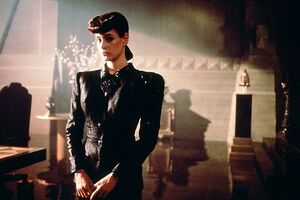No edit summary |
m (→top: add cat) |
||
| (3 intermediate revisions by 2 users not shown) | |||
| Line 1: | Line 1: | ||
| + | {{Real-world}} |
||
[[File:Rachael-blade-runner.jpg|thumb|300px|Rachael]] |
[[File:Rachael-blade-runner.jpg|thumb|300px|Rachael]] |
||
Another issue that permeates ''[[Blade Runner]]'' is the role of women. This is explored through the treatment and defining of lead female roles, which all happen to be artificial ([[replicant]]s) and sexualized by the men around them. This gives whole new meaning to the term "objectifying women" since they are manufactured. |
Another issue that permeates ''[[Blade Runner]]'' is the role of women. This is explored through the treatment and defining of lead female roles, which all happen to be artificial ([[replicant]]s) and sexualized by the men around them. This gives whole new meaning to the term "objectifying women" since they are manufactured. |
||
| − | * [[ |
+ | * [[Pris]] is a "basic pleasure model". |
* [[Zhora]] becomes an erotic dancer performing with a snake. |
* [[Zhora]] becomes an erotic dancer performing with a snake. |
||
* [[Rachael]] is supposed to be a copy of [[Sarah Tyrell|Tyrell's niece]] (with implanted memories). Her ambiguous part-secretary, part femme-fatale character can be read as being objectified – one of the questions in her [[Voight-Kampff machine|Voight-Kampff]] test seems to question her sexuality. "Is this testing whether I'm a replicant or lesbian Mr. [[Rick Deckard|Deckard]]?" |
* [[Rachael]] is supposed to be a copy of [[Sarah Tyrell|Tyrell's niece]] (with implanted memories). Her ambiguous part-secretary, part femme-fatale character can be read as being objectified – one of the questions in her [[Voight-Kampff machine|Voight-Kampff]] test seems to question her sexuality. "Is this testing whether I'm a replicant or lesbian Mr. [[Rick Deckard|Deckard]]?" |
||
| Line 12: | Line 13: | ||
[[File:Zhora at Taffey's.jpg|thumb|150px|Zhora]] |
[[File:Zhora at Taffey's.jpg|thumb|150px|Zhora]] |
||
| − | Arguably, the use of women as victims is meant to elicit sympathy from the audience (a Voight-Kampff test) and moreover can be read as a postmodern critique of the film-noir archetype. In this view, Blade Runner exposes the femme-fatale stereotype as dead. Furthermore, the race of the replicants implies a critique of females in Hollywood films. |
+ | Arguably, the use of women as victims is meant to elicit sympathy from the audience (a Voight-Kampff test) and moreover can be read as a postmodern critique of the film-noir archetype. In this view, Blade Runner exposes the femme-fatale stereotype as dead. Furthermore, the race of the replicants implies a critique of females in Hollywood films. |
[[Category:Themes]] |
[[Category:Themes]] |
||
| + | [[Category:Real-world articles]] |
||
Revision as of 03:15, 8 January 2020

Rachael
Another issue that permeates Blade Runner is the role of women. This is explored through the treatment and defining of lead female roles, which all happen to be artificial (replicants) and sexualized by the men around them. This gives whole new meaning to the term "objectifying women" since they are manufactured.
- Pris is a "basic pleasure model".
- Zhora becomes an erotic dancer performing with a snake.
- Rachael is supposed to be a copy of Tyrell's niece (with implanted memories). Her ambiguous part-secretary, part femme-fatale character can be read as being objectified – one of the questions in her Voight-Kampff test seems to question her sexuality. "Is this testing whether I'm a replicant or lesbian Mr. Deckard?"
Depending on one's view of replicants, she then becomes Deckard's "love interest" or "love object".
- Tyrell's niece is an unseen character.
- Mary was going to be a mother-figure replicant, but her part was axed.
The film-noir setting provides further context of the portrayal of women in film, with the femme-fatale historically portraying women as dangerous, uncaring, devious, sexualized and deadly as a reaction to changing roles after World War II. J.F. Sebastian is lured by Pris' sexuality, a naked Zhora catches Deckard off-guard, and then there is the forbidden love with Rachael. Critics may believe Blade Runner misogynist, given that Pris and Zhora can be seen as "strong, independent and non-subservient women" who are killed, whereas Rachael who is the opposite lives. This point, however, must be seen in light of the dystopian setting, in which strong, independent characters of either gender are typically systematically removed.

Zhora
Arguably, the use of women as victims is meant to elicit sympathy from the audience (a Voight-Kampff test) and moreover can be read as a postmodern critique of the film-noir archetype. In this view, Blade Runner exposes the femme-fatale stereotype as dead. Furthermore, the race of the replicants implies a critique of females in Hollywood films.
